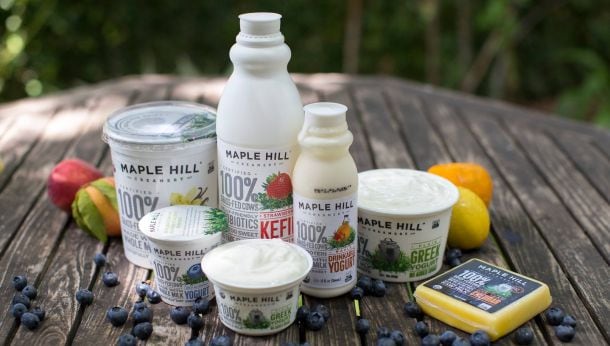Touted as easier to digest than conventional milk due to the absence of the A1 milk protein, a2 Milk has been steadily building its business in the US, and is now in over 27,000 stores at most major retailers.
"We've seen extremely strong growth - over 80% CAGR growth - in the business over the last five years, which really surpasses the global forecast for the A1-free category," Waltrip told FoodNavigator-USA.
This past year, the company saw its revenue in North America grow by 30% to $82.7m for the 12 months ended June 30, 2022 (although a significant increase in freight costs and higher raw milk costs pushed it into the red).
USDA figures show that average US per capita fluid milk consumption has declined by nearly 29% between 2000 and 2019, noted Waltrip.
"Total milk’s been declining from a conventional perspective for over twenty years. The premium milk business is still the largest growth driver of the total milk business.
"The only way out of long-term declining commodity categories is through innovation. It has always has been the case and will always be the case. Innovation is critical to adding value and creating consumer interest."
Broad consumer appeal: 'They just view it as a better milk'
New innovation in the fluid milk category has ignited new interest from consumers who are responding to more premium-positioned products such as a2 Milk.
While billed as a more tummy-friendly option for consumers, many of the consumers buying a2 Milk have no digestion issues at all, noted Waltrip, which speaks to the brand's mass consumer appeal.
In fact, over two-thirds of a2 Milk consumers in Australia (where the company was founded) report having no milk intolerance issues.
"They just view it as a better milk," said Waltrip.
"We’re seeing that same dynamic develop here in the US where a great percentage of our consumer base doesn’t report having milk intolerance issues."
The mass consumer appeal has translated into 10+% household penetration in the US market.
New segments, new opportunities
To secure its future success, a2 Milk has extended into new categories of chocolate through a co-branded partnership with Hershey and launched its own version of a2 Half & Half, both of which are bringing incremental growth to retailers where they are sold.
"The half & half category is a $1bn+ category growing at about 6%, but hasn’t had innovation in a decade. And we bring in an easier-on-digestion proposition with a2 Milk and we’re seeing tremendous gains on that in terms of consumer interest," said Waltrip.
As for a2 Milk Hershey's aseptic chocolate milk, the products have been accepted into over 6,000 stores including Walmart and Sam's Club.
In terms of future innovation, Waltrip said the company's has a robust pipeline that extends well beyond fluid milk.
"You can think of a lot of categories where dairy is a primary ingredient but not in a fluid milk format where there are significant opportunities for innovation," he said
"You only have to look at some of the things happening in plant-based over the last several years. There’s no reason milk can’t innovate in similar sorts of fashion."
One such innovation eventually coming to market is the brand's infant formula.
"We’ve just been granted by the FDA enforcement discretion to begin the path of introducing our infant formulas in the United States. It’s a highly regulated category and will take some time, but there are tremendous opportunities when you look at life stage and developing products that are appropriate for consumers in different phases of their life stage, which have been dominated for years by the same players," added Waltrip.
Managing inflation
Asked about the impact of inflation and supply chain challenges, Waltrip said, "Inflationary pressures are something that everyone is dealing with all the way throughout the supply chain. The input costs for milk are up dramatically. Milk prices have reached some of the highest levels in history."
Working through its co-packing network of three major suppliers in the US has helped stabilize its business, according to Waltrip.
"Freight is a major issue for any milk company. You need to really think about where you ideally place your sources of production so you can get to the market. I’m pleased to say we have very high service levels with our retailers," he said.
The company took an 11% price increase to its products to cover some of its increased expenses.
"Pleasingly we’re not seeing an impact so far from a consumer takeaway perspective since we’ve increased our price. I think that play into the value proposition we’ve built on the brand," he added.
2023 outlook
"As we go into 2023, we’re looking to expand our proposition, leverage innovation more significantly across the portfolio so we have more touch points with the consumer and at the same time, focus on our fiscal contributions as a publicly-traded company," said Waltrip.


